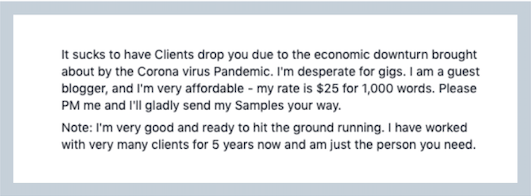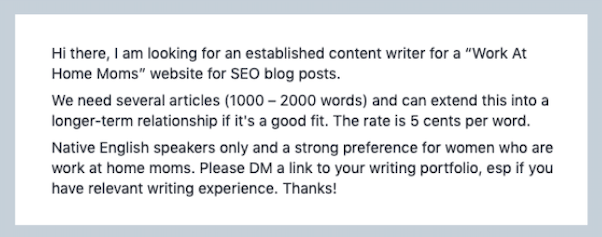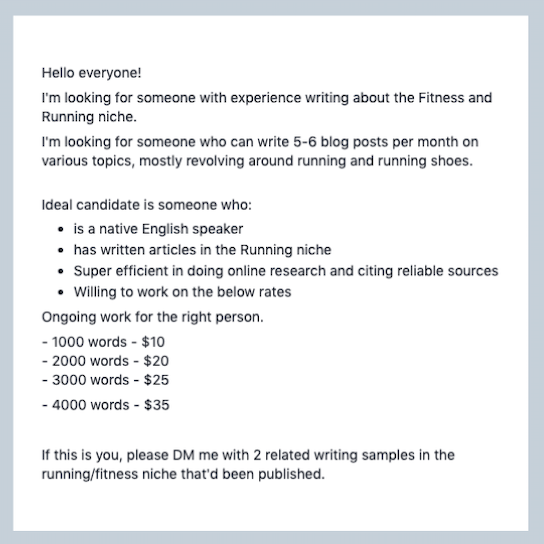Resources
Rates During a Downturn: How Low Can You Go?
By Margie Zable Fisher April 29th, 2020Freelancers are hearing bad news everywhere. Unemployment is at a record high, and competition for gigs is up as laid-off full-timers hunt for contract work. Freelancers whose clients have canceled projects or slashed budgets are scrambling. New writers are entering the market and may be driving down fees.
A recent survey from Freelancers Union found that three-quarters of freelancers have lost work due to the coronavirus, and 90% expect future losses.
Amid the gloom and doom, what’s a freelancer to do? Should you lower your rates? Or are there other strategies you can use to stay afloat?
We checked in with freelancers, agencies, and experts for their thoughts.
Are freelancers accepting lower rates during the coronavirus crisis?
If you’ve spent any time on social media lately, you’ve probably seen desperation posts like these (Editor’s Note: posts anonymized to protect user privacy):


Most likely you’ve also seen posts from newbies, or people back in the market:


All of this might lead you to believe that most freelancers are lowering rates, and that you need to jump on the bandwagon to get work.
Not necessarily, according to Jennifer Goforth Gregory, a Raleigh, NC-based B2B tech writer and author of The Freelance Content Marketing Writer.
“If you’re struggling to feed your family and keep the lights on, take whatever work you can get to survive,” she said. “When you’re in emergency mode, you don’t need to feel bad about lowering your rates.”
But Goforth Gregory stresses that freelancers should exercise caution when accepting lower-fee projects and view it as a short-term solution while hunting for better-paying work, she said. “Unfortunately, I’ve seen many writers take lower-paying gigs during a financial emergency, and stay [there] instead of moving back to their normal rates.”
For some, a race to the bottom
Some agencies are passing tighter client budgets downstream to freelancers in the form of lower fees.
Larissa Pickens, principal and creative director of Float Design, recently posted this in the private Facebook group Cult of Copy Job Board:

Pickens received double the replies she usually does and ended up hiring someone she had worked with in the past at a higher rate.
“I didn’t even reach out to her for this, because for previous projects I had paid her 10 cents a word,” said Pickens. “But the client had a tighter budget, and this freelancer replied to the ad and was willing to work for 50% less.”
Others are offering next to nothing for assignments, though we can’t say for sure whether these basement-scraping rates are a result of coronavirus opportunism:


Goforth Gregory suggests overlooking “offers” like these and investing time in hunting for better-paying gigs, which often won’t turn up in your news feed. “The clients who need us the most and are willing to pay well are too busy to reach out to anyone,” she said. “We need to find them.”
Some freelancers are holding steady on rates during coronavirus
Some freelancers have managed to keep their rates steady through a combination of referrals and assignments from companies that are doing well during the pandemic.
“So far, my income hasn’t changed much due to COVID-19,” said Danielle Antosz, a writer and editor from Chicago, IL. “My niche is mostly SaaS, tech, and business, so most of my clients are still in need of content.” She did lose one client and another put a hold on work, but others needed more content related to the virus, or are in e-commerce, which she says is thriving.
“I’ve also had people in my network offering work directly, which has been a lifesaver.”
Adam Kimmel, a technical content writer from Milwaukee, WI, has had similar luck: “I am in a specialty [engineering] niche and have not seen much change in project rates due to COVID-19.”
Kathleen Hanover, a Dayton, Ohio-based marketing copywriter and public relations consultant, admits she took on some low-paying clients in March, after suffering a $10,000 blow from a cancelled project. “My typical minimum project fee for a new client is $1,000,” she said. “I waived that while business was really slow, and I ended up doing a job at about 75% off what I would usually charge.”
Business has picked up considerably in the last few weeks for Hanvoer, who is back to charging pre-crisis rates. She typically bills $4,995 for a complete direct mail package.
One thing Hanover has learned from lowering her rates: “The less you charge, the less clients listen or take you seriously.”
Cashing in on coronavirus
Some freelancers are making more money now than they were before the pandemic.
“There is a ton of work, and rush fees are available, too,” said Goforth Gregory. A B2B tech writer, most of her clients supply the technology that companies are using to move to remote work. Almost all of her clients scaled up on content production during the pandemic because people started using products differently. She says she has never worked so hard, and she met her six-month revenue goal for 2020 before the end of April—a first.
Kelly McSweeney, a Littleton, MA-based science and technology writer, has seen an increase in work since the pandemic broke out. “In March and April, I doubled my revenue goal, which was to meet my previous full-time salary while working less than 20 hours each week,” she reported.
Surprisingly, quarantining boosted her productivity last week while she self-isolated due to COVID-19 symptoms. “I got more work done that week than in the previous three weeks combined,” she said. “I still took naps, rested, took my temperature, etc., but I had mild symptoms and ‘a room of one’s own’ while my husband took over childcare and housekeeping.”
Thanks to the lockdown, she was able to say yes to 24-hour turnarounds for COVID-19 assignments for a research hospital—a dream client, in her words.
Strategies to get more work and earn more money during the coronavirus crisis
Whether you are hanging on by your fingernails or working 24/7, there are ways to sustain or even improve your freelance income during the pandemic and beyond:
- Focus on niches that pay well and have a need for content. B2B, technology, science, health, and e-commerce are likely to be strong areas.
- Look for industries that have pivoted to survive and need to get the word out: Examples include restaurants that are now offering pickup and delivery and health and mental health practitioners who are now providing tele-health services.
- Reach out to past clients to see if you can get work. Persistence and followup are important, especially since clients who need content the most are often busy.
- Build relationships. Now is the time to send referrals to other freelancers (we all hear about opportunities that aren’t right for us, but would be great for someone else). You can also share tips and resources. If the law of reciprocity holds, you’ll receive opportunities and help, too.
- Pivot quickly. Pay attention to fields where new opportunities are emerging, and find ways to align your skills to their needs.
But your best strategy during this tumultuous time may be to hustle, according to Goforth Gregory. “The difference between a successful and an unsuccessful writer isn’t about writing skill,” she says. “Certainly, you need to be a good writer. But to be a successful one, you must be proactive—building relationships, reaching out to previous and potential clients, and being open to new niches and opportunities.”
Margie Zable Fisher has more than 20 years of experience writing about business, personal finance, health, fitness, e-commerce, lifestyle, personal development, and aging.
Build a Contently portfolio for the chance to freelance for top brands.
Photo credit: tommy